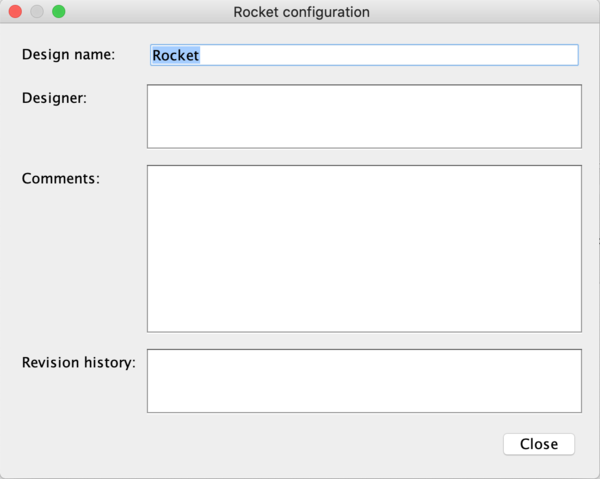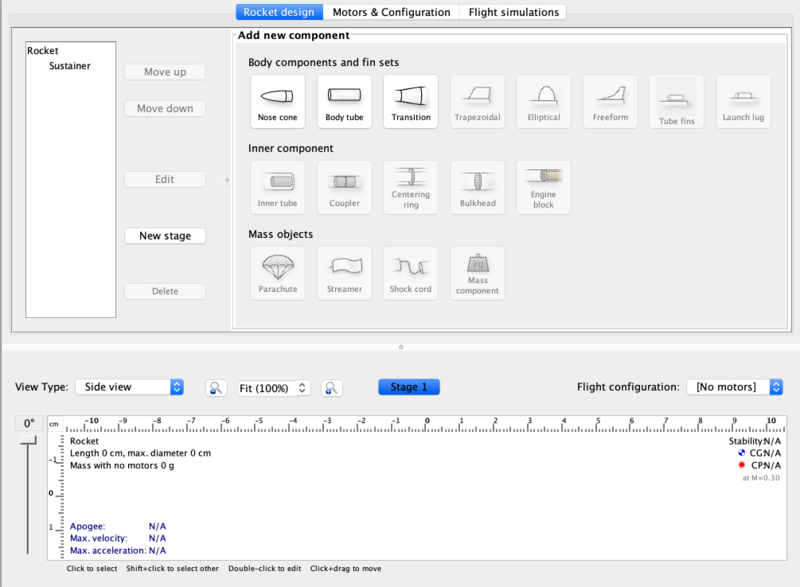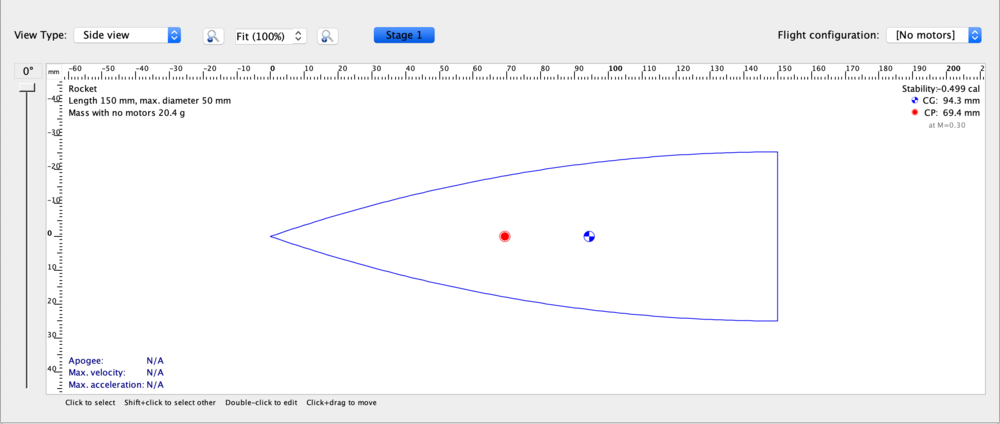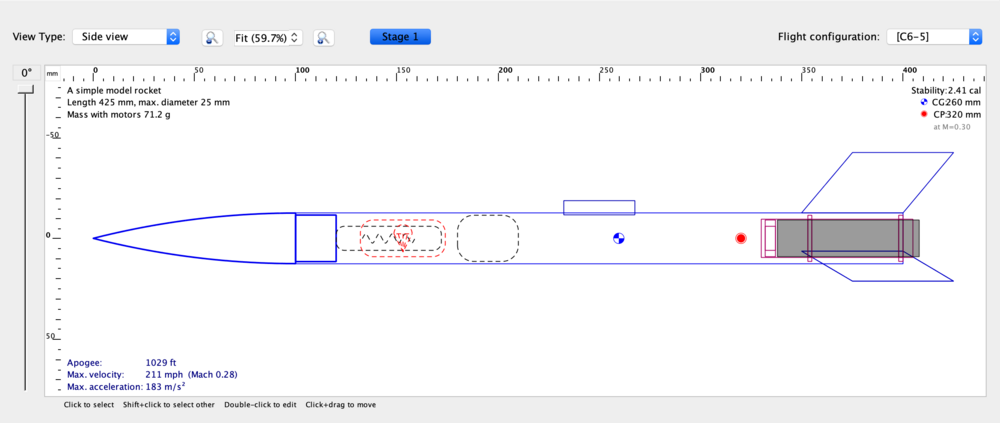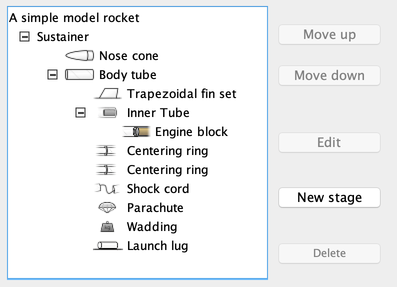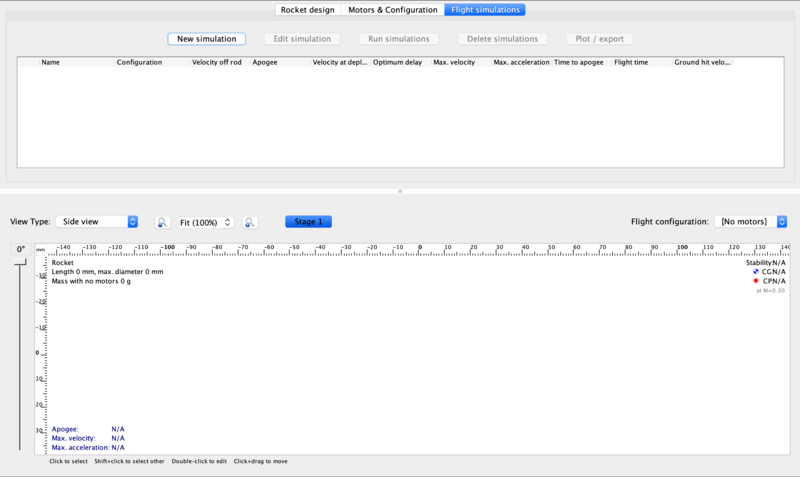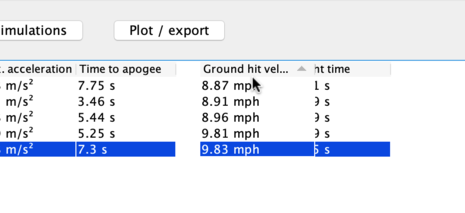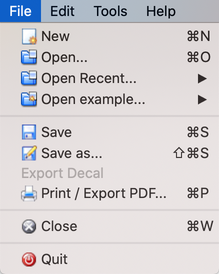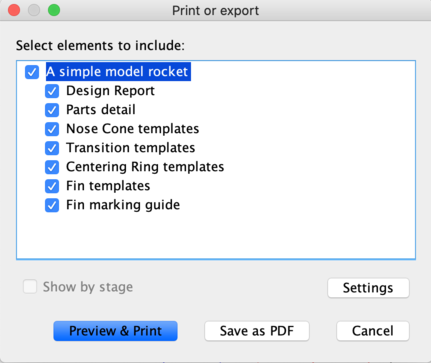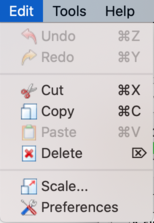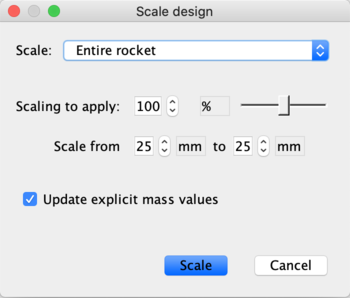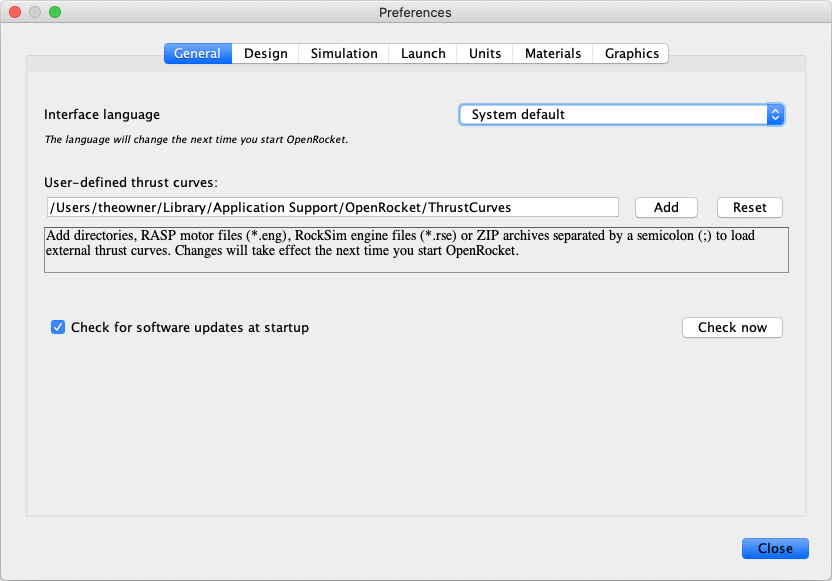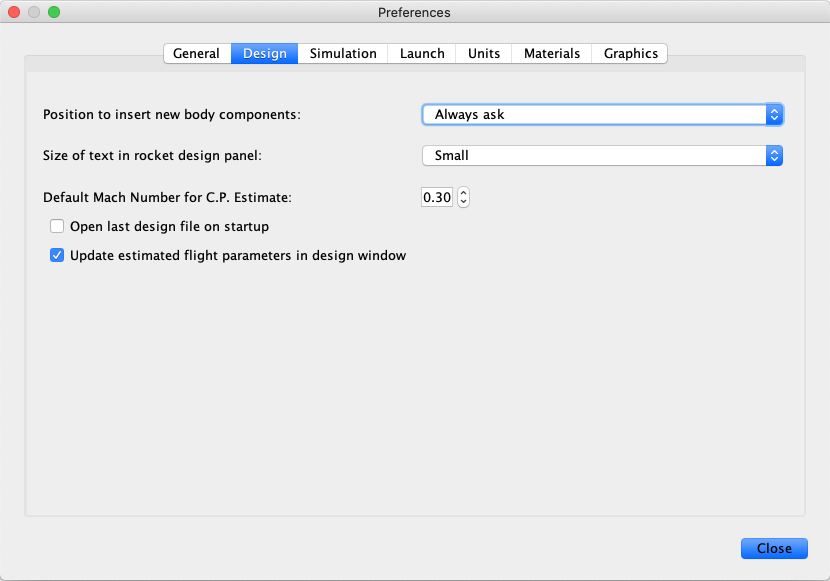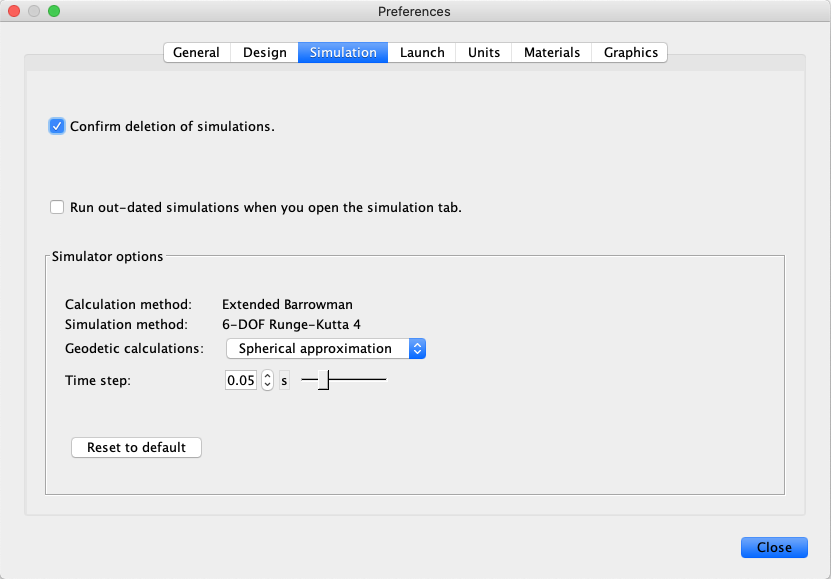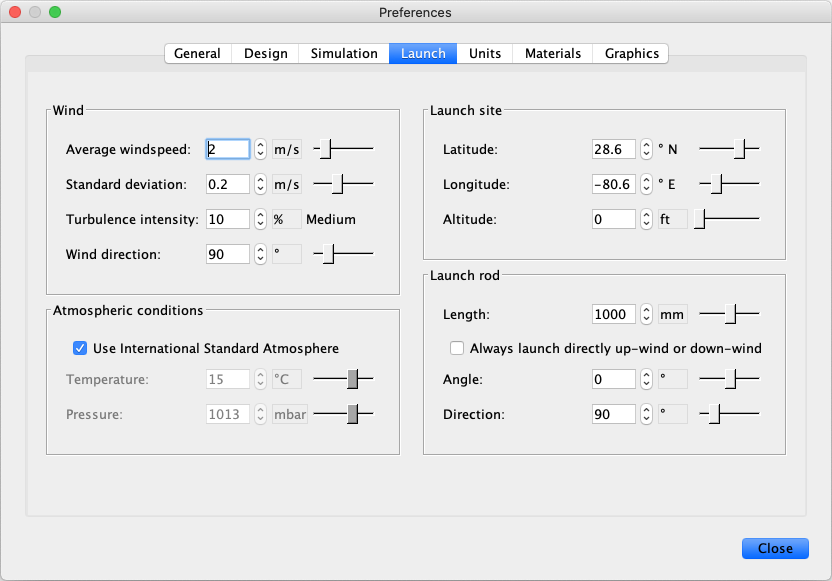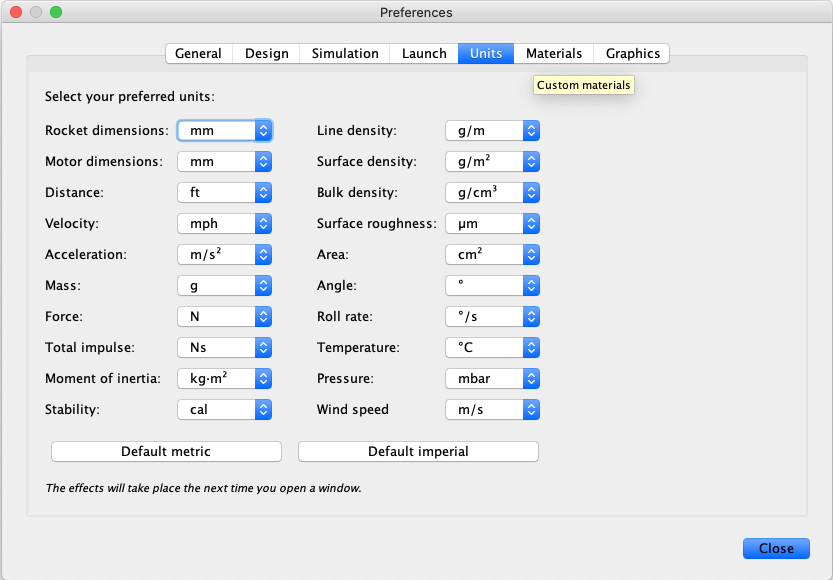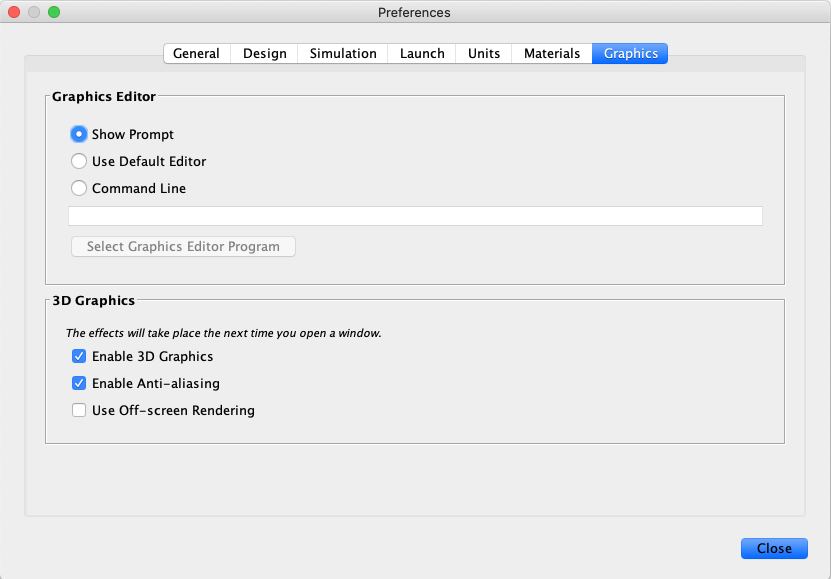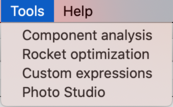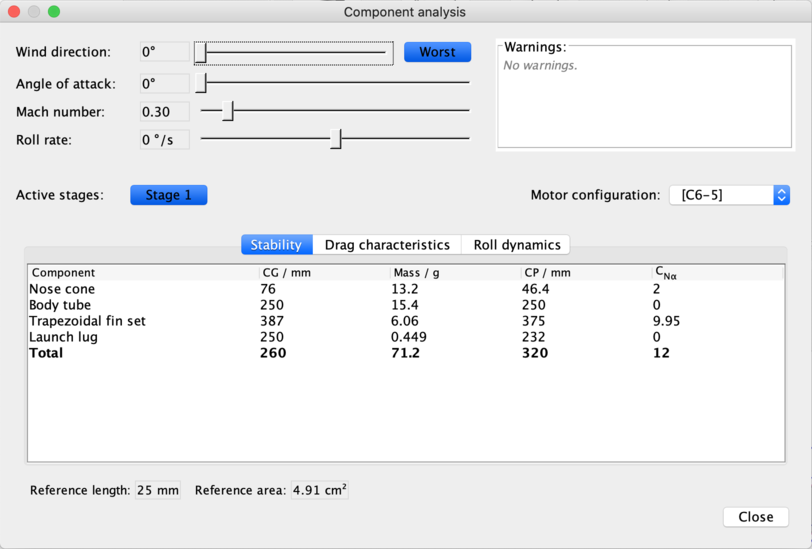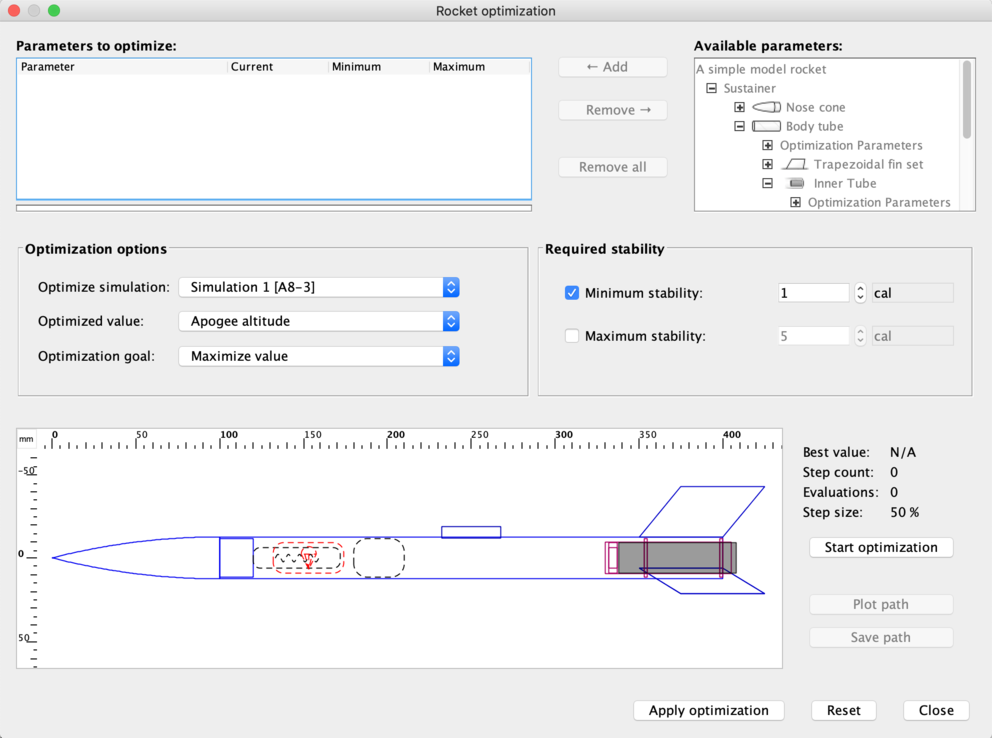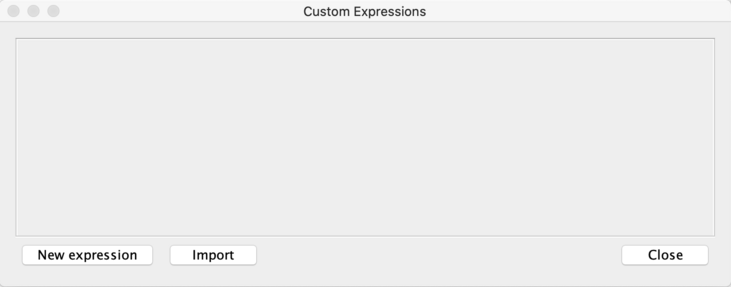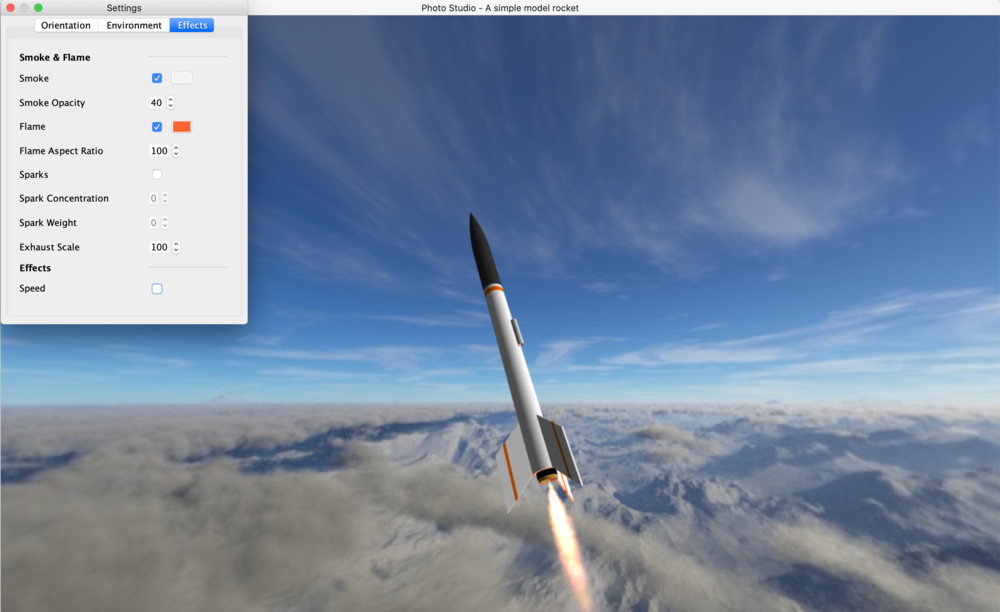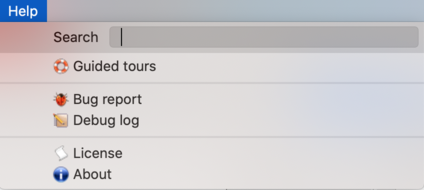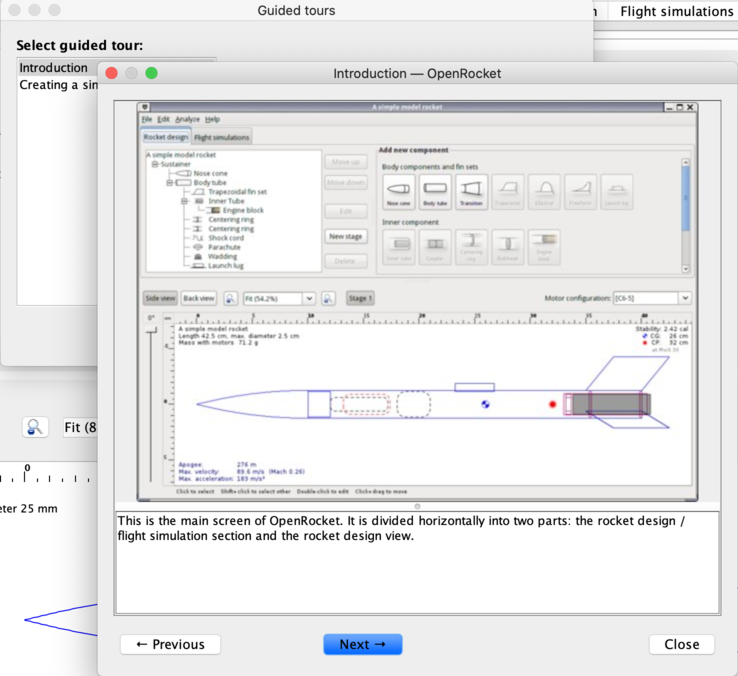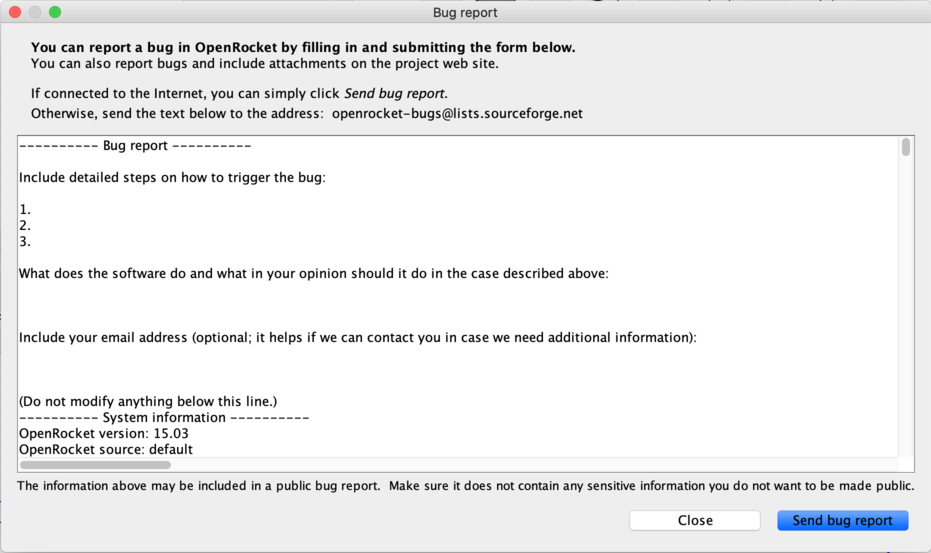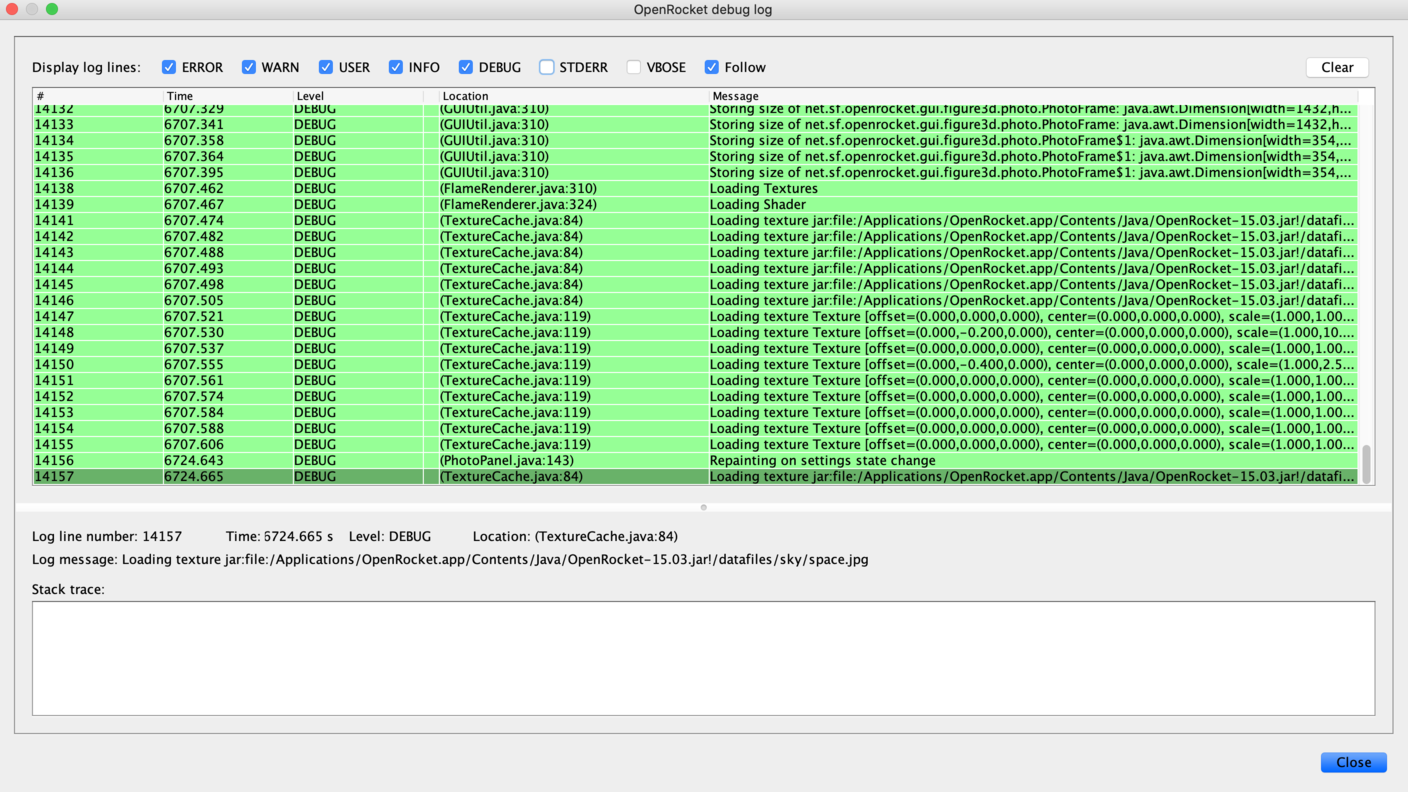Difference between revisions of "Getting Started"
m (Updated Edit Menu width) |
m |
||
| (33 intermediate revisions by the same user not shown) | |||
| Line 2: | Line 2: | ||
<div style="float: left;">[[Downloading & Installing|← Downloading & Installing]]</div> | <div style="float: left;">[[Downloading & Installing|← Downloading & Installing]]</div> | ||
<div style="float: right;">[[Basic Rocket Design|Basic Rocket Design →]]</div> | <div style="float: right;">[[Basic Rocket Design|Basic Rocket Design →]]</div> | ||
| − | [[ | + | [[Main Page|↑ Back to Contents]] |
</div> | </div> | ||
{{UserGuideHelp}} | {{UserGuideHelp}} | ||
| − | |||
__TOC__ | __TOC__ | ||
| − | In this section we have a look at how OpenRocket is organized, by analyzing in detail the structure of the <strong>user interface</strong>. We will also briefly mention the <strong>Example projects</strong> that are accessible from the <em>File</em> menu. After reading this section you will have a thorough understanding of how OpenRocket is structured, and will be ready to start designing a rocket of your own. If you already know how this program is organized, feel free to jump to the | + | |
| + | In this section we have a look at how OpenRocket is organized, by analyzing in detail the structure of the <strong>user interface</strong>. We will also briefly mention the <strong>Example projects</strong> that are accessible from the <em>File</em> menu. After reading this section you will have a thorough understanding of how OpenRocket is structured, and will be ready to start designing a rocket of your own. If you already know how this program is organized, feel free to jump to [[Basic Rocket Design]], the next section. | ||
| Line 22: | Line 22: | ||
You can double-click the rocket's name in the main window, to enter information about your design in the Rocket Configuration window: | You can double-click the rocket's name in the main window, to enter information about your design in the Rocket Configuration window: | ||
| + | |||
[[File:Rocket_configuration.png|thumb|600 px|center|The <em>Rocket Configuration</em> window.]] | [[File:Rocket_configuration.png|thumb|600 px|center|The <em>Rocket Configuration</em> window.]] | ||
| + | |||
It's a good idea to fill in this information when you start a new rocket project. Fill in the four fields (or you can leave all, except the <em>Design name</em>, blank if you wish), and click the <em>close</em> button. <br /> | It's a good idea to fill in this information when you start a new rocket project. Fill in the four fields (or you can leave all, except the <em>Design name</em>, blank if you wish), and click the <em>close</em> button. <br /> | ||
| Line 30: | Line 32: | ||
You now have access to the <strong>OpenRocket <em>main window</em></strong>. | You now have access to the <strong>OpenRocket <em>main window</em></strong>. | ||
| + | |||
[[File:Main_window.png|thumb|800 px|center|The OpenRocket <em>main window</em>.]] | [[File:Main_window.png|thumb|800 px|center|The OpenRocket <em>main window</em>.]] | ||
| + | |||
Notice there are three tabs in the top of the window. These tabs allow you to switch between the <em>Rocket design</em>, <em>Motors and Configuration</em>, and <em>Flight simulations</em> windows. <br /> | Notice there are three tabs in the top of the window. These tabs allow you to switch between the <em>Rocket design</em>, <em>Motors and Configuration</em>, and <em>Flight simulations</em> windows. <br /> | ||
| Line 37: | Line 41: | ||
=== The <em>Rocket design</em> window === | === The <em>Rocket design</em> window === | ||
| − | + | {{anchor|rocketdesignwindow}} | |
For the moment, let's focus on the <em>Rocket design</em> window. This window is organized in the following way: <br /> | For the moment, let's focus on the <em>Rocket design</em> window. This window is organized in the following way: <br /> | ||
- in the bottom half of the window there is a large white space. This is where a 2D image of the rocket you are designing will appear. <br /> | - in the bottom half of the window there is a large white space. This is where a 2D image of the rocket you are designing will appear. <br /> | ||
| Line 44: | Line 48: | ||
Now let's have a closer look at the bottom half of the <em>Rocket design</em> window. When you add a component to your rocket, it will be immediately displayed, as shown below: | Now let's have a closer look at the bottom half of the <em>Rocket design</em> window. When you add a component to your rocket, it will be immediately displayed, as shown below: | ||
| + | |||
[[File:After_first_component.png|thumb|1000 px|center|Bottom half of the <em>Rocket design</em> window after adding a <strong>nose cone</strong>.]] | [[File:After_first_component.png|thumb|1000 px|center|Bottom half of the <em>Rocket design</em> window after adding a <strong>nose cone</strong>.]] | ||
| + | |||
Notice the <strong>rulers</strong> around the borders. These give you an idea of the dimensions of your rocket. <br /><br /> | Notice the <strong>rulers</strong> around the borders. These give you an idea of the dimensions of your rocket. <br /><br /> | ||
| Line 54: | Line 60: | ||
Finally, notice the drop-down list in the top right-hand corner of the previous image. This allows you to choose which of your <strong>motor configurations</strong> to apply to the rocket you have designed (more on this later). The image below shows how the bottom half of the <em>Rocket design</em> window appears after the rocket design has been completed. | Finally, notice the drop-down list in the top right-hand corner of the previous image. This allows you to choose which of your <strong>motor configurations</strong> to apply to the rocket you have designed (more on this later). The image below shows how the bottom half of the <em>Rocket design</em> window appears after the rocket design has been completed. | ||
| + | |||
[[File:After_complete_design.png|thumb|1000 px|center|Bottom half of the <em>Rocket design</em> window after completing the rocket's design (taken from the <em>A simple model rocket</em> example design).]] | [[File:After_complete_design.png|thumb|1000 px|center|Bottom half of the <em>Rocket design</em> window after completing the rocket's design (taken from the <em>A simple model rocket</em> example design).]] | ||
| + | |||
In this image, the rocket's <strong>body components</strong> and <strong>fin sets</strong> are represented with a continuous blue line; the rocket's <strong>inner components</strong> are represented with a continuous red line (the <strong>inner tube</strong> is also filled in with a grey background); and the <strong>mass objects</strong> are represented with either black or red dotted lines. It is also possible to customize the colour in which each part is represented, as will be shown later on. The image below shows how the top left-hand portion of the <em>Rocket design</em> window looks after the rocket design has been completed. | In this image, the rocket's <strong>body components</strong> and <strong>fin sets</strong> are represented with a continuous blue line; the rocket's <strong>inner components</strong> are represented with a continuous red line (the <strong>inner tube</strong> is also filled in with a grey background); and the <strong>mass objects</strong> are represented with either black or red dotted lines. It is also possible to customize the colour in which each part is represented, as will be shown later on. The image below shows how the top left-hand portion of the <em>Rocket design</em> window looks after the rocket design has been completed. | ||
| + | |||
[[File:Structure.png|thumb|397 px|center|Top left-hand portion of the <em>Rocket design</em> window after completing the rocket's design (taken from the <em>A simple model rocket</em> example design).]] | [[File:Structure.png|thumb|397 px|center|Top left-hand portion of the <em>Rocket design</em> window after completing the rocket's design (taken from the <em>A simple model rocket</em> example design).]] | ||
| + | |||
As you can see, the rocket's components have a tree-like structure: <br /> | As you can see, the rocket's components have a tree-like structure: <br /> | ||
| Line 75: | Line 85: | ||
Now we have a look at the <em>Flight simulations</em> window, which you can access by selecting the <em>Flight simulations</em> tab in the top left-hand corner of the <em>OpenRocket main window</em>. Before designing your rocket or running any flight simulation, the <em>Flight simulations</em> window looks like this: | Now we have a look at the <em>Flight simulations</em> window, which you can access by selecting the <em>Flight simulations</em> tab in the top left-hand corner of the <em>OpenRocket main window</em>. Before designing your rocket or running any flight simulation, the <em>Flight simulations</em> window looks like this: | ||
| + | |||
[[File:Empty_simulations.png|thumb|800 px|center|The <em>Flight simulations</em> window before designing the rocket and running any simulation.]] | [[File:Empty_simulations.png|thumb|800 px|center|The <em>Flight simulations</em> window before designing the rocket and running any simulation.]] | ||
| − | Notice that the bottom part of the window does not change when switching from the <em>Rocket Design</em> window to the <em>Flight simulations</em> window. Hence we only need to analyze the top part of the window. Here, most of the space is occupied by a currently blank space, where the technical details about your simulations will appear. Above this space there are five buttons, which allow you to <strong>program a new simulation</strong> (<em>New simulation</em>), <strong>edit a selected simulation</strong> (<em>Edit simulation</em>), for example by changing motor configuration or some atmospheric condition, <strong>run all the simulations you have programmed</strong> (<em>Run simulations</em>), <strong>remove the selected simulations</strong> (<em>Remove simulations</em>), or either <strong>plot or export some of the results of a selected simulation</strong>(<em>Plot/export</em>). (More on exporting simulation results in [ | + | |
| + | Notice that the bottom part of the window does not change when switching from the <em>Rocket Design</em> window to the <em>Flight simulations</em> window. Hence we only need to analyze the top part of the window. Here, most of the space is occupied by a currently blank space, where the technical details about your simulations will appear. Above this space there are five buttons, which allow you to <strong>program a new simulation</strong> (<em>New simulation</em>), <strong>edit a selected simulation</strong> (<em>Edit simulation</em>), for example by changing motor configuration or some atmospheric condition, <strong>run all the simulations you have programmed</strong> (<em>Run simulations</em>), <strong>remove the selected simulations</strong> (<em>Remove simulations</em>), or either <strong>plot or export some of the results of a selected simulation</strong>(<em>Plot/export</em>). (More on exporting simulation results in [[Rocket Analysis]].)<br /> <br /> | ||
The image below shows how the top part of the <em>Rocket Design</em> window looks after you have designed your rocket, programmed some simulations and run them. | The image below shows how the top part of the <em>Rocket Design</em> window looks after you have designed your rocket, programmed some simulations and run them. | ||
| + | |||
[[File:Simulations.png|thumb|1000 px|center|The top half of the <em>Flight simulations</em> window after having programmed and run some simulations (taken from the <em>A simple model rocket</em> example design).]] | [[File:Simulations.png|thumb|1000 px|center|The top half of the <em>Flight simulations</em> window after having programmed and run some simulations (taken from the <em>A simple model rocket</em> example design).]] | ||
| − | + | ||
| + | |||
Notice that five of the six simulations that have been run have a green tick on the left: this means that the simulation has been completed without any <strong>warnings</strong>. Conversely, if the simulation has generated some <strong>warning</strong> while being run, a red exclamation mark is shown (as for the third simulation in the image above). To find out the more about the warning, mouse-over the simulation (without clicking) as shown in the image below. | Notice that five of the six simulations that have been run have a green tick on the left: this means that the simulation has been completed without any <strong>warnings</strong>. Conversely, if the simulation has generated some <strong>warning</strong> while being run, a red exclamation mark is shown (as for the third simulation in the image above). To find out the more about the warning, mouse-over the simulation (without clicking) as shown in the image below. | ||
| + | |||
[[File:Warning.png|thumb|1000 px|center|More information about <strong>warnings</strong> in the <em>Flight simulations</em> window.]] | [[File:Warning.png|thumb|1000 px|center|More information about <strong>warnings</strong> in the <em>Flight simulations</em> window.]] | ||
| − | + | ||
| + | |||
It is possible to change the position of the columns containing the various technical simulation data by simply dragging any column left or right, as shown below: | It is possible to change the position of the columns containing the various technical simulation data by simply dragging any column left or right, as shown below: | ||
| + | |||
[[File:Columns.png|thumb|465 px|center|Moving columns in the <em>Flight simulations</em> window.]] | [[File:Columns.png|thumb|465 px|center|Moving columns in the <em>Flight simulations</em> window.]] | ||
| + | |||
== The <em>main window</em>'s menus == | == The <em>main window</em>'s menus == | ||
| Line 100: | Line 118: | ||
The image below shows the options offered by the <strong><em>File</em></strong> menu, located in the top left-hand corner of OpenRocket's <em>main window</em>. | The image below shows the options offered by the <strong><em>File</em></strong> menu, located in the top left-hand corner of OpenRocket's <em>main window</em>. | ||
| + | |||
[[File:File.png|thumb|219 px|center|The <em>File</em> menu.]] | [[File:File.png|thumb|219 px|center|The <em>File</em> menu.]] | ||
| + | |||
The function of each option in the <em>File</em> menu is pretty straightforward to understand: <br /> | The function of each option in the <em>File</em> menu is pretty straightforward to understand: <br /> | ||
| Line 109: | Line 129: | ||
- <strong><em>Save</em></strong> saves the changes you have made to a previously-saved project. <br /> | - <strong><em>Save</em></strong> saves the changes you have made to a previously-saved project. <br /> | ||
- <strong><em>Save as...</em></strong> allows you to save the project you are working on to a new <em>*.ork</em> file. <br /> | - <strong><em>Save as...</em></strong> allows you to save the project you are working on to a new <em>*.ork</em> file. <br /> | ||
| − | - <strong><em>Print/Export PDF</em></strong> opens a window like the one shown below (if you have already completed your rocket's design). From here you can select what to include in your print/PDF file; such as technical details of your rocket's components, templates of your rocket's fin sets or even the design of your rocket. We suggest you try this option with one of the example projects to understand how each of these is represented when printing/exporting to PDF. More on printing and exporting to PDF in [ | + | - <strong><em>Print/Export PDF</em></strong> opens a window like the one shown below (if you have already completed your rocket's design). From here you can select what to include in your print/PDF file; such as technical details of your rocket's components, templates of your rocket's fin sets or even the design of your rocket. We suggest you try this option with one of the example projects to understand how each of these is represented when printing/exporting to PDF. More on printing and exporting to PDF in [[Rocket Analysis]]. |
<br /> | <br /> | ||
- <strong><em>Close</em></strong> closes the current project (after asking for confirmation if there are unsaved changes). This will also exit the application if there was only one project open. <br /> | - <strong><em>Close</em></strong> closes the current project (after asking for confirmation if there are unsaved changes). This will also exit the application if there was only one project open. <br /> | ||
- <strong><em>Quit</em></strong> exits the application, checking that you have saved all open projects. | - <strong><em>Quit</em></strong> exits the application, checking that you have saved all open projects. | ||
| + | |||
[[File:PDF.png|thumb|431 px|center|The window that opens when <em>Print/Export PDF</em> is selected.]] | [[File:PDF.png|thumb|431 px|center|The window that opens when <em>Print/Export PDF</em> is selected.]] | ||
| Line 120: | Line 141: | ||
The image below shows the options offered by the <strong><em>Edit</em></strong> menu. | The image below shows the options offered by the <strong><em>Edit</em></strong> menu. | ||
| + | |||
[[File:Edit.png|thumb|154 px|center|The <em>Edit</em> menu.]] | [[File:Edit.png|thumb|154 px|center|The <em>Edit</em> menu.]] | ||
| + | |||
These options are mostly the classic editing options: undo/redo some action (<strong><em>Undo</em></strong>/<strong><em>Redo</em></strong>) and cut/copy/paste/delete some element (<strong><em>Cut</em></strong>/<strong><em>Copy</em></strong>/<strong><em>Paste</em></strong>/<strong><em>Delete</em></strong>). We also have the following options: <br /> | These options are mostly the classic editing options: undo/redo some action (<strong><em>Undo</em></strong>/<strong><em>Redo</em></strong>) and cut/copy/paste/delete some element (<strong><em>Cut</em></strong>/<strong><em>Copy</em></strong>/<strong><em>Paste</em></strong>/<strong><em>Delete</em></strong>). We also have the following options: <br /> | ||
- <strong><em>Scale...</em></strong> opens the window shown below. Here you can choose to scale your rocket's size by some percentage (you can select from a range of 25% to 400%), starting from a specified dimension that can either be the one the rocket currently has or one you specify. By checking or unchecking the <em>Update explicit mass values</em> box, you can also decide whether or not the rocket's mass should be updated when scaling its volume. | - <strong><em>Scale...</em></strong> opens the window shown below. Here you can choose to scale your rocket's size by some percentage (you can select from a range of 25% to 400%), starting from a specified dimension that can either be the one the rocket currently has or one you specify. By checking or unchecking the <em>Update explicit mass values</em> box, you can also decide whether or not the rocket's mass should be updated when scaling its volume. | ||
| − | |||
| − | - <strong><em>Preferences</em></strong> opens the <em>Preferences</em> window, as shown below. At the top of this window there are | + | [[File:Scale.png|thumb|350 px|center|The <em>Scale</em> window.]] |
| + | |||
| + | |||
| + | - <strong><em>Preferences</em></strong> opens the <em>Preferences</em> window, as shown below. At the top of this window there are seven tabs which allow you to switch between various preference panes. | ||
| + | |||
| + | From the <em>General</em> pane, you can change the <strong>Interface Language</strong> to one of 13 translations. You'll need to restart OpenRocket to make the change take effect. | ||
| + | |||
| + | You can also load <strong>User-defined thrust curves</strong>, for motors not yet represented in OpenRocket's library. | ||
| + | |||
| + | From this pane, you can also check for an <strong>Update</strong>, or set your preferences for <strong>Update checking</strong>. | ||
| + | |||
| + | |||
| + | <div style="background-color:#FFFF00;border:1px solid black;margin:5px;padding:5px;"><strong>At this writing (December 2020), OpenRocket 15.03 tries to contact an out-of-date update source, and will not find future updates</strong>. | ||
| + | <br/>You should <em>un-check</em> this box, and periodically check [http://openrocket.info/ OpenRocket.info] for information on the latest version.</div> | ||
| + | |||
| + | |||
| + | [[File:Prefs-General.png|thumb|1000 px|center|The <em>General</em> pane of the <em>Preferences</em> window.]] | ||
| + | |||
| − | + | The <strong>Design</strong> tab brings up a preference pane where you can tell OpenRocket where to <strong>Position new body components</strong>, the default <strong>Size of text</strong>, the <strong>Default Mach number</strong> for Center of Pressure estimation, and OpenRocket's behavior in the <em>Design</em> window. | |
| − | |||
| − | [[File: | + | [[File:Prefs-Design.png|thumb|1000 px|center|The <em>Design</em> pane of the <em>Preferences</em> window.]] |
| − | |||
| − | + | The <strong>Simulation</strong> tab brings up a preference pane where you can control OpenRocket's behavior when working with simulations, and the options it uses for calculation in the <em>Flight simulations</em> window. | |
| − | + | [[File:Prefs-Simulation.png|thumb|1000 px|center|The <em>Simulation</em> pane of the <em>Preferences</em> window.]] | |
| − | |||
| − | + | The <strong>Launch</strong> tab brings up a preference pane where you can fix OpenRocket's default <strong>Wind</strong>,<strong>Atmospheric conditions</strong>, <strong>Launch site</strong>, and <strong>Launch rod</strong>, as used in the <em>Flight simulations</em> window. | |
| − | |||
| − | [[File: | + | [[File:Prefs-Launch.png|thumb|1000 px|center|The <em>Launch</em> pane of the <em>Preferences</em> window.]] |
| − | |||
| − | [[File:Optimization.png|thumb| | + | The <strong>Units</strong> tab brings up a preference pane where you can set your <strong>preferred units</strong> for every parameter, and completely reset <strong>metric</strong> or <strong>imperial</strong> units as used in all <em>OpenRocket</em> inputs. |
| + | |||
| + | |||
| + | [[File:Prefs-Units.png|thumb|1000 px|center|The <em>Units</em> pane of the <em>Preferences</em> window.]] | ||
| + | |||
| + | |||
| + | The picture below shows the <em>Materials</em> pane of the <em>Preferences</em> window. Here you can manage all of the available materials for the rocket component, by either <strong>editing the characteristics</strong> of the materials (i.e., their name and density) through the <em>Edit</em> button, or you can <strong>delete</strong> a material through the <em>Delete</em> button. You can also <strong>add new materials</strong> if you wish, by clicking the <em>New</em> button and setting the material's name, type and density. | ||
| + | |||
| + | |||
| + | [[File:Materials.png|thumb|1000 px|center|The <em>Materials</em> pane of the <em>Preferences</em> window.]] | ||
| + | |||
| + | |||
| + | The <strong>Graphics</strong> tab brings up a preference pane where you can choose your preferred <strong>Graphics Editor</strong> (for example, Photoshop, MS-Paint, GIMP, Affinity Photo, etc.), and enable and set parameters for <strong>3D Graphics</strong> in the <em>Rocket design</em> window. | ||
| + | |||
| + | |||
| + | [[File:Prefs-Graphics.png|thumb|1000 px|center|The <em>Graphics</em> pane of the <em>Preferences</em> window.]] | ||
| + | |||
| + | === The <em>Tools</em> menu === | ||
| + | |||
| + | The image below shows the options offered by the <strong><em>Tools</em></strong> menu. | ||
| + | |||
| + | |||
| + | [[File:ToolsMenu.png|thumb|173 px|center|The <em>Tools</em> menu.]] | ||
| + | |||
| + | |||
| + | - The <strong><em>Component analysis</em></strong> option opens a window like the one shown below. Here, technical information for the rocket's <strong>external components</strong> and fin sets is displayed. Using the scroll bars in the top half of the window you can also change some parameters, such as <strong>wind direction</strong>, <strong>angle of attachment</strong>, <strong>mach number</strong> and <strong>roll rate</strong>. More on the <em>component analysis</em> window in [[Rocket Analysis]]. | ||
| + | |||
| + | |||
| + | [[File:Component analysis.png|thumb|812 px|center|The <em>Component analysis</em> window, opened from the <em>A simple model rocket</em> example design.]] | ||
| + | |||
| + | |||
| + | - The <strong><em>Rocket optimization</em></strong> option opens a window like the one shown below. From here you can optimize the performance of your rocket by selecting exactly which performance to optimize from the <strong><em>Optimized</em></strong> drop-down list. More on the <em>rocket optimization</em> window in [[Rocket Analysis]]. | ||
| + | |||
| + | |||
| + | [[File:Optimization.png|thumb|992 px|center|The <em>Optimization</em> window, opened from the <em>A simple model rocket</em> example design.]] | ||
| + | |||
| + | |||
| + | - The <strong><em>Custom expressions</em></strong> option opens a window for adding and editing custom expressions, as shown below. In OpenRocket, you're not limited to using the built-in simulation variables in your plots and analysis. With the custom expression feature, you can write expressions to calculate other values of interest during the simulation. These can then be plotted or exported just like the built in variables. More on the <em>Custom Expression</em> window in [[Custom Expressions]]. | ||
| + | |||
| + | |||
| + | [[File:CustomExpressions.png|thumb|731 px|center|The <em>Custom Expressions</em> window.]] | ||
| + | |||
| + | |||
| + | - OpenRocket's <strong><em>Photo Studio</em></strong> (seen below) lets you visualize your rocket in flight, over a variety of backgrounds, in a variety of attitudes and lighting. Effects let you customize its engine exhaust and the way it's depicted. You can adjust parameters with the dialog panel, and adjust the view with the mouse. The best way to learn about the Photo Studio is to start playing with it - it's pretty fun, and if you've given your rocket color and assigned realistic materials, it can look very good! | ||
| + | |||
| + | |||
| + | [[File:PhotoStudio.png|thumb|1000 px|center|The <em>Photo Studio</em> window.]] | ||
| + | |||
=== The <em>Help</em> menu === | === The <em>Help</em> menu === | ||
| Line 159: | Line 240: | ||
The image below shows the options offered by the <strong><em>Help</em></strong> menu. | The image below shows the options offered by the <strong><em>Help</em></strong> menu. | ||
| − | |||
| − | < | + | [[File:Help.png|thumb|424 px|center|The <em>Help</em> menu.]] |
| − | + | ||
| + | |||
| + | The functions of the options in the <em>Help</em> menu are as follow: <br /><br /> | ||
| + | - <strong><em>Guided tours</em></strong> opens a window containing guided tours of some of OpenRocket's functionality. These tours are works in progress, and not exhaustive. <br /> | ||
| + | |||
| + | |||
| + | [[File:GuidedTours.png|thumb|738 px|center|The <em>Guided Tour</em> panel, with a tour open.]] | ||
| + | |||
| + | |||
| + | |||
| + | - <strong><em>Bug report</em></strong> opens a bug report form that you can complete and email to the developers. <br /> | ||
| + | |||
| + | |||
| + | <div style="background-color:#FFFF00;border:1px solid black;margin:5px;padding:5px;"><strong>At this writing (December 2020), OpenRocket 15.03 tries to contact an out-of-date bug-submission page, and will not submit the bug</strong>. You may see an error dialog with an email address. <strong>Do not</strong> submit to this email - it's not monitored. | ||
| + | <br/>Instead, fill out the report with steps to trigger, description, etc., then copy the text from this window and file your bug report as an issue at [https://github.com/openrocket/openrocket/issues OpenRocket's Issue List] on github.</div> | ||
| + | |||
| + | |||
| + | [[File:BugReport.png|thumb|931 px|center|The <em>Bug Report</em> panel]] | ||
| + | |||
| + | |||
| + | - <strong><em>Debug log</em></strong> opens the OpenRocket debug log. The debug log is mostly of interest to developers. The log window lets you filter to see all kinds of information about what OpenRocket is doing.<br /> | ||
| + | |||
| + | |||
| + | [[File:DebugLog.png|thumb|1408 px|center|The <em>Debug Log</em> panel.]] | ||
| + | |||
| + | |||
- <strong><em>License</em></strong> opens a window containing OpenRocket's license. <br /> | - <strong><em>License</em></strong> opens a window containing OpenRocket's license. <br /> | ||
| − | |||
| − | |||
- <strong><em>About</em></strong> opens a window containing summary information about this project. <br /><br /> | - <strong><em>About</em></strong> opens a window containing summary information about this project. <br /><br /> | ||
| Line 172: | Line 275: | ||
By now you should have a good idea of how OpenRocket's user interface is structured, so you might feel ready to start designing your own rocket (see next section)--and probably you are indeed ready. Nonetheless we suggest you have a look at some pre-designed example rockets that we have provided. To do this, simply select <em>File</em> -> <em>Open example...</em> and the window shown in the image below will appear. | By now you should have a good idea of how OpenRocket's user interface is structured, so you might feel ready to start designing your own rocket (see next section)--and probably you are indeed ready. Nonetheless we suggest you have a look at some pre-designed example rockets that we have provided. To do this, simply select <em>File</em> -> <em>Open example...</em> and the window shown in the image below will appear. | ||
| − | [[File:Example.png|thumb|1000 px|center|The <em>Open example | + | |
| + | [[File:Example.png|thumb|1000 px|center|The <em>Open example...</em> window.]] | ||
| + | |||
Select one or more of the listed rockets (we suggest that you start with <em>A simple model rocket</em>), then click <em>Open</em>. Now have a closer look at the various windows discussed in this section, and note how they change when you choose another example project. This should give you an idea of how to best use this application, and maybe even give you some new ideas for your future rockets! <br /><br /> | Select one or more of the listed rockets (we suggest that you start with <em>A simple model rocket</em>), then click <em>Open</em>. Now have a closer look at the various windows discussed in this section, and note how they change when you choose another example project. This should give you an idea of how to best use this application, and maybe even give you some new ideas for your future rockets! <br /><br /> | ||
| − | Now that you know how this program is structured, you can <strong>start using OpenRocket to design your own rockets</strong>. How to do this will be the topic of the | + | Now that you know how this program is structured, you can <strong>start using OpenRocket to design your own rockets</strong>. How to do this will be the topic of the next section, [[Basic Rocket Design]]. |
---- | ---- | ||
| Line 182: | Line 287: | ||
<div style="float: left;">[[Downloading & Installing|← Downloading & Installing]]</div> | <div style="float: left;">[[Downloading & Installing|← Downloading & Installing]]</div> | ||
<div style="float: right;">[[Basic Rocket Design|Basic Rocket Design →]]</div> | <div style="float: right;">[[Basic Rocket Design|Basic Rocket Design →]]</div> | ||
| − | [[ | + | [[Main Page|↑ Back to Contents]] |
</div> | </div> | ||
Revision as of 06:40, 10 March 2021
|
The current User's Guide is very much a work in progress, any help would be greatly appreciated! |
In this section we have a look at how OpenRocket is organized, by analyzing in detail the structure of the user interface. We will also briefly mention the Example projects that are accessible from the File menu. After reading this section you will have a thorough understanding of how OpenRocket is structured, and will be ready to start designing a rocket of your own. If you already know how this program is organized, feel free to jump to Basic Rocket Design, the next section.
The User interface
In this subsection we first briefly discuss the Rocket Configuration window, and then OpenRocket's main window and the main window's four menus.
The Rocket Configuration window
You can double-click the rocket's name in the main window, to enter information about your design in the Rocket Configuration window:
It's a good idea to fill in this information when you start a new rocket project. Fill in the four fields (or you can leave all, except the Design name, blank if you wish), and click the close button.
OpenRocket's main window
You now have access to the OpenRocket main window.
Notice there are three tabs in the top of the window. These tabs allow you to switch between the Rocket design, Motors and Configuration, and Flight simulations windows.
The Rocket design window
Template:Anchor
For the moment, let's focus on the Rocket design window. This window is organized in the following way:
- in the bottom half of the window there is a large white space. This is where a 2D image of the rocket you are designing will appear.
- in the top-left part of the window, the rocket's stages and components are shown. When you start a new project, the rocket contains only one stage (i.e.; the sustainer) but no components.
- in the top-right part of the window, all the body components and fin sets, inner components, and mass objects that you can add to the rocket are shown. Notice that it's not possible to add all of these objects to the rocket at any particular stage of the rocket design. Exactly which components can be added when will be explained later in this guide.
Now let's have a closer look at the bottom half of the Rocket design window. When you add a component to your rocket, it will be immediately displayed, as shown below:
Notice the rulers around the borders. These give you an idea of the dimensions of your rocket.
As you can see, in addition to the appearance of your rocket, the Rocket design window also shows some other useful information as well. This includes the rocket's dimensions, mass, apogee, max. velocity, max. acceleration, stability, center of gravity (CG), and center of pressure (CP).
In the top left-hand corner of the previous image there are two buttons: Side view and Back view. These allow you to visualize the rocket from two different positions. Next to these buttons you can find the zoom-regulation commands and then one Stage i button for each Stage in your rocket. Selecting/deselecting each of these allows you to include or exclude each stage from the picture. On the left of the previous image you can also see a scroll bar that allows you to rotate the rocket up to 360°.
Finally, notice the drop-down list in the top right-hand corner of the previous image. This allows you to choose which of your motor configurations to apply to the rocket you have designed (more on this later). The image below shows how the bottom half of the Rocket design window appears after the rocket design has been completed.
In this image, the rocket's body components and fin sets are represented with a continuous blue line; the rocket's inner components are represented with a continuous red line (the inner tube is also filled in with a grey background); and the mass objects are represented with either black or red dotted lines. It is also possible to customize the colour in which each part is represented, as will be shown later on. The image below shows how the top left-hand portion of the Rocket design window looks after the rocket design has been completed.
As you can see, the rocket's components have a tree-like structure:
- the Rocket, called A simple model rocket, has only one stage: the Sustainer.
- the Sustainer contains two body components: a Nose cone and a Body tube.
- the Body tube contains a fin set (in particular a Trapezoidal fin set), a Launch lug, three inner components (an Inner Tube and two Centering rings), and three mass objects (a Shock cord, a Parachute, and a Wadding).
- the Inner tube contains an Engine block.
This tree-like structure will be discussed further later in this guide.
The buttons visible on the left in the previous image have pretty straightforward functions. By selecting one of the rocket's components you can change its position in the list of components (but not its position in the rocket) by using the Move up and Move down buttons. You can also edit its characteristics (e.g., dimensions, material, mass, colour used to represent it within the rocket) by using the Edit button--or you can delete it from the rocket completely using the Delete button. Notice that none of these buttons is active in the above image, since no component has been selected.
You can also add an extra stage to your rocket by clicking the New stage button.
The Flight simulations window
Now we have a look at the Flight simulations window, which you can access by selecting the Flight simulations tab in the top left-hand corner of the OpenRocket main window. Before designing your rocket or running any flight simulation, the Flight simulations window looks like this:
Notice that the bottom part of the window does not change when switching from the Rocket Design window to the Flight simulations window. Hence we only need to analyze the top part of the window. Here, most of the space is occupied by a currently blank space, where the technical details about your simulations will appear. Above this space there are five buttons, which allow you to program a new simulation (New simulation), edit a selected simulation (Edit simulation), for example by changing motor configuration or some atmospheric condition, run all the simulations you have programmed (Run simulations), remove the selected simulations (Remove simulations), or either plot or export some of the results of a selected simulation(Plot/export). (More on exporting simulation results in Rocket Analysis.)
The image below shows how the top part of the Rocket Design window looks after you have designed your rocket, programmed some simulations and run them.
Notice that five of the six simulations that have been run have a green tick on the left: this means that the simulation has been completed without any warnings. Conversely, if the simulation has generated some warning while being run, a red exclamation mark is shown (as for the third simulation in the image above). To find out the more about the warning, mouse-over the simulation (without clicking) as shown in the image below.
It is possible to change the position of the columns containing the various technical simulation data by simply dragging any column left or right, as shown below:
We now analyze the four main window's menus, briefly explaining the function of each of the menus' options.
The image below shows the options offered by the File menu, located in the top left-hand corner of OpenRocket's main window.
The function of each option in the File menu is pretty straightforward to understand:
- New allows you to start a new project, without closing the project that is currently open.
- Open... allows you to open a *.ork file that you have saved on your computer.
- Open example... allows you to open one of the example projects (more on these later).
- Save saves the changes you have made to a previously-saved project.
- Save as... allows you to save the project you are working on to a new *.ork file.
- Print/Export PDF opens a window like the one shown below (if you have already completed your rocket's design). From here you can select what to include in your print/PDF file; such as technical details of your rocket's components, templates of your rocket's fin sets or even the design of your rocket. We suggest you try this option with one of the example projects to understand how each of these is represented when printing/exporting to PDF. More on printing and exporting to PDF in Rocket Analysis.
- Close closes the current project (after asking for confirmation if there are unsaved changes). This will also exit the application if there was only one project open.
- Quit exits the application, checking that you have saved all open projects.
The image below shows the options offered by the Edit menu.
These options are mostly the classic editing options: undo/redo some action (Undo/Redo) and cut/copy/paste/delete some element (Cut/Copy/Paste/Delete). We also have the following options:
- Scale... opens the window shown below. Here you can choose to scale your rocket's size by some percentage (you can select from a range of 25% to 400%), starting from a specified dimension that can either be the one the rocket currently has or one you specify. By checking or unchecking the Update explicit mass values box, you can also decide whether or not the rocket's mass should be updated when scaling its volume.
- Preferences opens the Preferences window, as shown below. At the top of this window there are seven tabs which allow you to switch between various preference panes.
From the General pane, you can change the Interface Language to one of 13 translations. You'll need to restart OpenRocket to make the change take effect.
You can also load User-defined thrust curves, for motors not yet represented in OpenRocket's library.
From this pane, you can also check for an Update, or set your preferences for Update checking.
You should un-check this box, and periodically check OpenRocket.info for information on the latest version.
The Design tab brings up a preference pane where you can tell OpenRocket where to Position new body components, the default Size of text, the Default Mach number for Center of Pressure estimation, and OpenRocket's behavior in the Design window.
The Simulation tab brings up a preference pane where you can control OpenRocket's behavior when working with simulations, and the options it uses for calculation in the Flight simulations window.
The Launch tab brings up a preference pane where you can fix OpenRocket's default Wind,Atmospheric conditions, Launch site, and Launch rod, as used in the Flight simulations window.
The Units tab brings up a preference pane where you can set your preferred units for every parameter, and completely reset metric or imperial units as used in all OpenRocket inputs.
The picture below shows the Materials pane of the Preferences window. Here you can manage all of the available materials for the rocket component, by either editing the characteristics of the materials (i.e., their name and density) through the Edit button, or you can delete a material through the Delete button. You can also add new materials if you wish, by clicking the New button and setting the material's name, type and density.
The Graphics tab brings up a preference pane where you can choose your preferred Graphics Editor (for example, Photoshop, MS-Paint, GIMP, Affinity Photo, etc.), and enable and set parameters for 3D Graphics in the Rocket design window.
The image below shows the options offered by the Tools menu.
- The Component analysis option opens a window like the one shown below. Here, technical information for the rocket's external components and fin sets is displayed. Using the scroll bars in the top half of the window you can also change some parameters, such as wind direction, angle of attachment, mach number and roll rate. More on the component analysis window in Rocket Analysis.
- The Rocket optimization option opens a window like the one shown below. From here you can optimize the performance of your rocket by selecting exactly which performance to optimize from the Optimized drop-down list. More on the rocket optimization window in Rocket Analysis.
- The Custom expressions option opens a window for adding and editing custom expressions, as shown below. In OpenRocket, you're not limited to using the built-in simulation variables in your plots and analysis. With the custom expression feature, you can write expressions to calculate other values of interest during the simulation. These can then be plotted or exported just like the built in variables. More on the Custom Expression window in Custom Expressions.
- OpenRocket's Photo Studio (seen below) lets you visualize your rocket in flight, over a variety of backgrounds, in a variety of attitudes and lighting. Effects let you customize its engine exhaust and the way it's depicted. You can adjust parameters with the dialog panel, and adjust the view with the mouse. The best way to learn about the Photo Studio is to start playing with it - it's pretty fun, and if you've given your rocket color and assigned realistic materials, it can look very good!
The image below shows the options offered by the Help menu.
The functions of the options in the Help menu are as follow:
- Guided tours opens a window containing guided tours of some of OpenRocket's functionality. These tours are works in progress, and not exhaustive.
- Bug report opens a bug report form that you can complete and email to the developers.
Instead, fill out the report with steps to trigger, description, etc., then copy the text from this window and file your bug report as an issue at OpenRocket's Issue List on github.
- Debug log opens the OpenRocket debug log. The debug log is mostly of interest to developers. The log window lets you filter to see all kinds of information about what OpenRocket is doing.
- License opens a window containing OpenRocket's license.
- About opens a window containing summary information about this project.
The Example projects
By now you should have a good idea of how OpenRocket's user interface is structured, so you might feel ready to start designing your own rocket (see next section)--and probably you are indeed ready. Nonetheless we suggest you have a look at some pre-designed example rockets that we have provided. To do this, simply select File -> Open example... and the window shown in the image below will appear.
Select one or more of the listed rockets (we suggest that you start with A simple model rocket), then click Open. Now have a closer look at the various windows discussed in this section, and note how they change when you choose another example project. This should give you an idea of how to best use this application, and maybe even give you some new ideas for your future rockets!
Now that you know how this program is structured, you can start using OpenRocket to design your own rockets. How to do this will be the topic of the next section, Basic Rocket Design.
